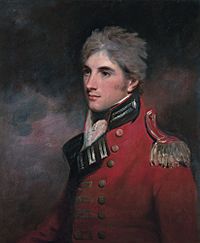George Murray (British Army officer) facts for kids
Quick facts for kids
Sir George Murray
|
|
|---|---|

George Murray portrait by John Hoppner RA
|
|
| Secretary of State for War and the Colonies | |
| In office 30 May 1828 – 22 November 1830 |
|
| Monarch | George IV William IV |
| Prime Minister | The Duke of Wellington |
| Preceded by | William Huskisson |
| Succeeded by | The Viscount Goderich |
| Personal details | |
| Born | 6 February 1772 Perth, Perthshire |
| Died | 28 July 1846 (aged 74) Belgrave Square, London |
| Nationality | British |
| Political party | Tory |
| Spouse |
Louisa Erskine (m. 1825)
|
| Children | 1 |
Sir George Murray (born 6 February 1772 – died 28 July 1846) was an important British soldier and politician from Scotland. He held many high-ranking positions in the army and government during his life.
Contents
Early Life and Education
George Murray was born in Perth, Scotland, in 1772. He was the second son of Sir William Murray. He went to school at the Royal High School in Edinburgh and later studied at the University of Edinburgh. His mother was Lady Augusta Mackenzie.
Military Career and Achievements
George Murray began his army career in 1789 when he became an officer in the 71st Foot regiment. He quickly moved up the ranks, becoming a captain in 1794.
Serving in Major Wars
Murray served in several important military campaigns:
- He fought in Flanders (a region in Europe) from 1794 to 1795.
- He also saw action in the West Indies, England, and Ireland.
In 1799, he became a lieutenant-colonel. He joined the Quartermaster General's Department, which is in charge of planning and supplies for the army. This is where he became very well-known.
The Peninsular War
From 1808 to 1811, Murray was the Quartermaster General during the Peninsular War. This was a big war fought in Spain and Portugal against Napoleon's French army. He worked closely with the famous Duke of Wellington. Murray was promoted to Colonel in 1809.
He was part of many major battles during this war, including:
He received the Peninsular Gold Medal for his service, which had six clasps. Clasps are like extra awards on a medal, showing he fought in many important battles. Only a few other officers, like the Duke of Wellington, had more clasps than him.
After the Peninsular War
After the war, Murray briefly went to Canada in 1814 and 1815. He was appointed as the temporary Lieutenant-Governor of Upper Canada and checked the country's defenses. He quickly returned to Europe when Napoleon escaped from Elba, but he arrived too late to fight in the Battle of Waterloo.
After the wars ended, Murray continued his military career:
- He was the Chief of Staff for the Army of Occupation in France.
- In 1819, he became the Governor of the Royal Military College, Sandhurst, which is a famous army training school.
- He received an honorary degree from the University of Oxford in 1820.
- In 1824, he was elected a Fellow of the Royal Society, a group of important scientists.
- He later became the Commander-in-Chief in Ireland.
Political Career and Public Service
Sir George Murray was also active in politics. He was a member of the Tory party, which later became the Conservative Party.
Serving in Parliament
He was a Member of Parliament (MP) for Perthshire from 1824 to 1832, and again from 1834 until he retired in 1835.
Government Minister
From 1828 to 1830, he served as the Secretary of State for War and the Colonies. This was a very important job where he was in charge of the army and Britain's colonies around the world. He was also the Master-General of the Ordnance, a role dealing with military supplies and equipment, from 1834 to 1835 and again from 1841 to 1846.
Other Important Roles
Murray held other significant public positions:
- He was the President of the Royal Geographical Society from 1833 to 1835, a group that explores and studies geography.
- He was also the Governor of Edinburgh Castle and Fort George in Scotland.
Personal Life
In 1825, George Murray married Lady Louisa Erskine. They had one daughter named Louise Georgina. Sir George Murray passed away in July 1846 at the age of 74. He was buried in Kensal Green Cemetery in London. His important papers and maps were later given to the National Library of Scotland.
Legacy and Places Named After Him
Sir George Murray is remembered for his long and successful career in both the military and politics.
Many places around the world were named in his honor:
- In eastern Australia, the Murray River and Mount Murray are named after him.
- In Western Australia, there is another Murray River and Murray County.
- The city of Perth, Western Australia, was named after his parliamentary area, Perthshire.
- In Hong Kong, several places bear his name, including Murray House, Murray Building, Murray Road, and the former Murray Barracks.
His service is also remembered at the Royal Military Academy Sandhurst, where a memorial honors him.
Images for kids


